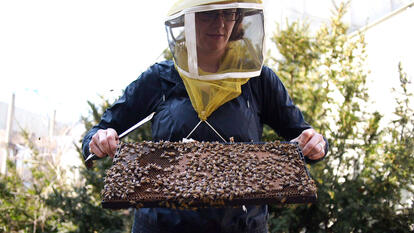
Life Finds a Way: Asexual Weevils Know How to Adapt
The other night, as I was getting ready to make risotto for dinner, I picked up a package of Arborio rice and noticed a hole in the side of the bag. Something was unusual about the rip, though—it seemed as if it had been torn from the inside. I cut open the package to investigate, and there they were: dozens of weevils swarming around the grains of uncooked grains.
I shouldn’t have been surprised because, to paraphrase Jeff Goldblum in Jurassic Park, weevils find a way. New research by Andrea Sequeira, Gordon and Althea Lang ’26 Professor of Biological Sciences, and a team of scientists from Wellesley and the University of Buenos Aires has shown us how.
Weevils are common invasive beetles found in many parts of the world, and they are talented at adapting to their environments and surroundings. Some weevil species are all asexual and female—they produce only female offspring from unfertilized eggs—and yet they still adapt to their environments over time despite not having the benefit of evolutionary genetic variation that accompanies meiotic reproduction—when offspring receive chromosomes from two different parents. The focus of Sequeira and her team’s research is how they manage to do that.
They have discovered that the weevils are able to digest different toxins in the plants they eat. Their findings, published in PLOS ONE, have implications for how we understand asexual invaders and how successful they can be because of gene regulation. Sequeira and Ava Mackay-Smith ’20, Mary Kate Dornon ’17, Rosalind Lucier ’22, Anna Okimoto ’19, Flavia Mendonca de Sousa, laboratory specialist in biological sciences at Wellesley, and Martina Königer, adjunct assistant professor of biological sciences, collected samples of Naupactus cervinus and N. leucoloma from Florida, California, and Argentina over the course of five years, starting in 2015. Despite being from different locations where they have been introduced, often through commerce, the weevils are asexual and genetically identical. Yet the team found that they have uniquely adapted to produce different proteins that allow them to eat and digest a variety of plants, even those that produce toxins.

Along with their colleagues at the University of Buenos Aires, also all women, the team analyzed patterns of gene expression in the weevils, looking at three gene categories that can mediate weevil-host plant interactions through identification of suitable host plants, short-term acclimation to host plant defenses, and long-term adaptation to host plant defenses and their pathogens.
“We found that some host plant groups, such as legumes, appear to be more taxing for weevils and elicit a complex gene expression response,” Sequeira said. “However, the way weevils respond to taxing or difficult host plants shares many aspects with other stressful situations, such as feeding on organic host plants and transitioning to novel hosts. This suggests to us that there is a common set of evolutionarily favorable ways of dialing up or down the expression of certain genes or gene categories for responding to different types of stressful situations.”
“We also found that mothers are able to ‘prime’ their young with these epigenetic changes,” said lead author Mackay-Smith. (Epigenetic changes are caused by the impact of one’s behavior or environment, as opposed to genetic changes in one’s DNA.) “Originally, we thought that these changes would only be seen in a single generation. When we studied larvae, who do not yet have mouths or eat plants, we found evidence of the same proteins and adaptations from their mothers.”
Sequeira noted this finding is especially important because it had been previously thought that in both sexual and asexual reproduction, all epigenetic marks are erased between generations and each generation starts over. Sequeira compares the genetic variation available to recently introduced weevils to packing a suitcase for a trip—you will only have the clothes in your bag, not the variety you would have if you had access to your entire wardrobe at home. But instead, she said, “These introduced mothers are essentially giving their offspring a pep talk, and preparing them for the harsh realities of the herbivorous insect world in their new home, by passing down these gene regulation ‘tips’ from one generation to the next.” It’s as if you went to a craft store while on that trip and bought ribbons or sequins to stitch onto the clothes you packed to make them more appropriate for the place you are visiting.
Mackay-Smith believes that having a better understanding of epigenetic changes in invasive, asexual species may eventually help regulate or mitigate their potential negative impact on an environment, native plants, or crops, for example. “Knowing what is in this insect’s repertoire, you could imagine that since we’ve now identified the proteins that are regulated differently, you could target a specific protein and design a targeted pesticide that removes only that species of weevil, without harming other native insects or fauna,” she said.
Both Mackay-Smith and Sequeira are excited to see that genetic variation may not be the only form of heritable variation for natural selection to act upon, and that epigenetic processes may increase the evolutionary potential of organisms in response to stress and other environmental challenges—adaptations that could be relevant in the context of climate change.
And as for me, I will not be horrified the next time I find a weevil in a bag of rice; instead, I will look at her with wonder.


